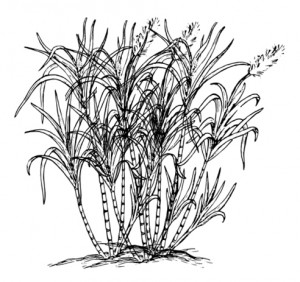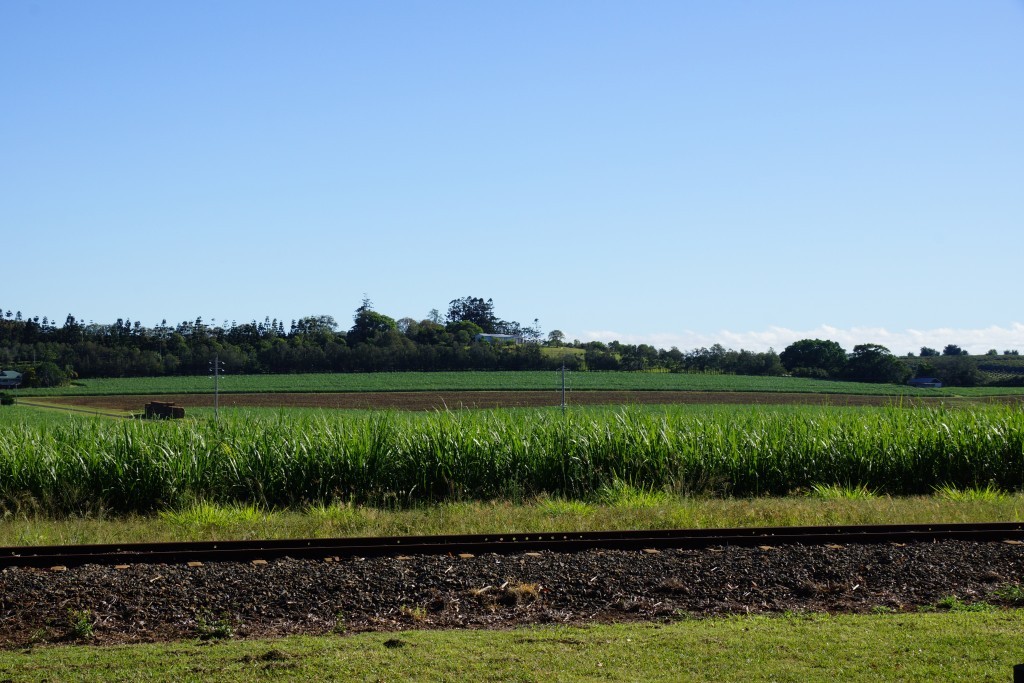As one heads towards the tropics of coastal north-eastern Australia, there is a distinct change in the fields that surround – as the green pastures transform to enormous fields of sugarcane . . .
During harvest season, the roads are littered with short stalks of the cane and squashed cane toads – one feels a real element of tropical, agricultural, Australia. . .
 Sugarcane (Saccharum officinarum) is a tall, perennial grass, resembling bamboo. It is a member of the Poaceae (Gramineae) grass family and is widely cultivated, providing around 70% of the world’s sugar – the balance being derived from beet. Sugarcane yields the highest number of calories per unit area of cultivation, of any plant.
Sugarcane (Saccharum officinarum) is a tall, perennial grass, resembling bamboo. It is a member of the Poaceae (Gramineae) grass family and is widely cultivated, providing around 70% of the world’s sugar – the balance being derived from beet. Sugarcane yields the highest number of calories per unit area of cultivation, of any plant.
Sugar is actually made in the leaves of the sugarcane plant by a natural process called ‘photosynthesis’. It is then stored as sweet juice in the bamboo-like stalks – rather like an animal stores fat.
Very briefly, photosynthesis is the process whereby plants take up the carbon dioxide in the air though the pores in their leaves – mix it with water and nutrients absorbed via their roots – using the Sun’s energy, which is harnessed by the plant’s chlorophyll, (incidentally, chlorophyll is green, hence, the reason why plants are generally green) – resulting in plant growth and energy stores.
Sugarcane was introduced into Australia by the First Fleet in 1788 !!! However, growing sugarcane in Australia was not immediately successful, as it requires strong sunlight; fertile, well-drained soils; temperatures above 21ºC; flat to gently sloping fields; and an annual rainfall of at least 1.5 m per year.
 It was to take some 74 years before the first viable sugarcane plantation of 8 hectares was accomplished by Captain Louis Hope and John Buhot in Brisbane – in 1862. The success saw Captain Hope increase his crops and open Australia’s first raw sugar mill at Ormiston, near Brisbane, in 1865. By 1867, sugarcane crops had increased by 100 fold, to some 800 hectares in the Brisbane District, and, it had begun spreading northward. The demand saw sugar mills being built at Maryborough and Mackay in 1866, Bundaberg in 1872 and Cairns in 1882.
It was to take some 74 years before the first viable sugarcane plantation of 8 hectares was accomplished by Captain Louis Hope and John Buhot in Brisbane – in 1862. The success saw Captain Hope increase his crops and open Australia’s first raw sugar mill at Ormiston, near Brisbane, in 1865. By 1867, sugarcane crops had increased by 100 fold, to some 800 hectares in the Brisbane District, and, it had begun spreading northward. The demand saw sugar mills being built at Maryborough and Mackay in 1866, Bundaberg in 1872 and Cairns in 1882.
It was sometime prior to 1865 that Captain Hope sought Pacific Islanders to work his plantation . . .
Just prior to the success of the sugarcane crops, on the 6th June 1859, Queen Victoria signed the Queensland Letters Patent (UK) forming Queensland as a colony. This new northern colony desperately required a workforce to take on the back-breaking work needed to cultivate and develop Queensland. The settlers knew all too well that ‘black’ labour in other parts of the world had achieved all manner of success due to the benefit of a cheap, hopefully even free, workforce – the source of Queensland’s ‘workforce‘ was found close by – on the islands of the South Pacific Ocean . . .
Growing, harvesting and processing sugarcane was immensely labour intensive which ultimately lead to inventions and innovation of machinery, which, in turn, replaced the immense manpower and horsepower of old . . .
” . . . Let us try to picture the scene as it was a the height of the crushing season, with the mill on the bank of one of the wide tidal rivers, a primitive tramline linking it with the wharf, more or less substantial, just as business, not safety, required. Alongside the mill were cook-house, blacksmith’s forge, and wheelwright’s shop, with the houses of the white employés, and further on the huts of the kanakas. The “boys” loved to make huts after their own island model, and cool they certainly were in summer, but other advantages were not apparent to the white observer. And yet it was with difficulty that the islanders could be persuaded to occupy the large frame houses specially built for them. Beyond and around on every side were waving canefields, while the grinding of the rollers and whirr of wheels could be heard afar off. Sometimes the mill worked late, and the islanders held high holiday, receiving some slight concession o payment for their overwork. And often were boiling operations carried on all night. Rain had a tendency to lower the density ; that is, weaken the sugar content of the cane, and thus there was bustle when cane cutting began until it was finished. Such was the system in use during the first ten years of sugar-growing in Queensland, and it served.
Then came an improvement in the system of treatment inaugurated on the Mary River, and then at Bundaberg, for a patent was secured by Messrs. Tooth and Cran, of Yengarie, and later of Millaquin and Bundaberg, whereby the extra amount of lime necessary to be added to the cane juice to prevent fermentation could be extracted after its purpose had served. For the system was in brief to avoid transporting the cane by conveying the juice. The theory was that every cane-grower should possess a small crushing plant, the can juice being run into tanks on the old-time punts and floated to the central mill . . . “
Excerpt: “The History of Queensland: Its People and Industries” by Matt. J. Fox – pp 47 – published 1923
.
The Life Cycle of Sugarcane
Following the cutting of the sugarcane, the next crop is either a ‘ratoon’ crop, or a freshly planted field of ‘billets’ or ‘setts’.
As sugarcane requires healthy and well drained soils, much effort must be made to improve soil health between crops.
New methods being used are the growing of legume crops in break year of each cropping cycle; mulching unwanted matter back into the soil rather than burning the crops; introducing wider row spacings to allow for controlled trafficking of machinery, thereby reducing the compaction of the soil; and, reducing tillage.
Legumes are known for their nitrogen (N) fixing properties. Some legumes such as peanuts, cowpeas, soybeans, and fava beans, are good nitrogen fixers – fixing some 115 kg of nitrogen per acre.
The process of legumes fixing nitrogen into the soils beings with the formation of nodules in their root systems, which the rhizobia bacteria present in the soil invades – then multiplies. It is this clever bacteria that has the ability to convert the voluminous inert N2 situate in the atmosphere, into biologically accessible NH3.
Healthy soils mean fewer root pathogens, improved soil structure, fewer weeds, increased cane growth and hence, yield.
Ratoon Crop
A ratoon crop grows from the root stock remaining below ground after harvest, from the previous crop. Generally 2 to 3 ratoon crops are grown from each planting.
Billet Planting
Billets or setts are generally cut from crops grown specifically for the purpose of planting.
Billets are cut at approximately 30 cm in length, and generally contain 3 buds. The billets must be fresh, genetically pure, pest and disease free.
Billets are mechanically planted by feeding them into furrows some 10 cm deep and between 1.5 to 1.8 m apart (depending on the size of the machinery that must fit between the rows). Fertiliser is added, the billets are covered with soil, and the soil compressed. A network of ditches is used to irrigate and drain the fields.
After a few weeks new shoots grow from buds on the joints of the billets, and break through the surface of the soil. Up to 12 stalks can grow from each billet, forming what is known as a ‘stool’ of sugarcane.
In Australia, sugarcane is planted between mid-August to October. A crop of sugarcane takes between 9 to 16 months to grow in Queensland, and in northern New South Wales, where the climate is already getting cooler, it takes approximately 18 to 24 months to grow. At maturity it achieves some 2 to 4 metres in height.
Sugarcane is grown along 1,800 km of Australia’s north-eastern coastline – from Mossman in far north Queensland to Grafton in northern New South Wales.
Harvesting
Australia’s sugarcane is generally harvested in the drier months of the tropics – being between July to December – weather permitting.
Nowadays, the harvesting process is all mechanical. A sugarcane harvester drives along the rows, cutting the cane stalk at the base of the plant. These stalks are then cut into billets. A sugarcane haulout machine drives alongside the harvester, collecting the billets, which are then transported to a sugarcane mill via truck or rail. Transport to the mill must be as quick as possible to minimise evaporation and deterioration of the cut cane.
Milling
Sugar mills are usually located in close proximity to the fields. They work day and night during cane harvesting season. They must handle the sugarcane promptly, to ensure that the quantity and quality of juice is maintained.
Once transported, the billets are shredded, rupturing the juice cells. The shredded sugarcane is then crushed by a series of rollers which separates the juice from the fibrous material. The fibrous material is called ‘bagasse’ – which is the fuel used to run the mill’s boiler furnaces. Ash and mud from the mill is returned to the cane field as fertilizer.
The juice is pumped away for processing into raw sugar. It is cleaned to remove impurities, and boiled to reduce excess water – resulting in a syrup. The syrup seeded with tiny sugar crystals in a vacuum pan, and boiled until sugar crystals form and grow. The sugar crystals are then separated from the ‘molasses’ that surrounds them, via centrifuges that resemble giant spin dryers. The Molasses is the dark syrup which is separated from raw sugar crystals during the milling process. It is used in distilleries, baking and for stock feed. Rum is distilled from fermented molasses . . .
The raw sugar crystals are then tumble-dried and stored in large bins, ready for transport to the various ports situate along Australia’s coastline – from whence it is exported to the rest of the world.
Some 80% of Australia’s product is exported overseas as ‘raw’ sugar, where it is further processed. Australia is the world’s second largest exporter of raw sugar – following Brazil.
Refining
Raw sugar, which is considered the intermediate product, requires ‘refining’ to produce the white sugar we are all so familiar with.
The refining process involves washing and dissolving the raw sugar crystals in hot water. Carbon dioxide and lime are added to the dissolved sugar in order to remove impurities. The substance is then filtered through a cloth, removing any remaining colours and impurities. The resultant product is boiled in a vacuum pan and seeded with fine sugar crystals. When the crystals have grown to the required size, they are tumble-dried to remove moisture. The final product, white sugar, is graded by size.
Australian refineries process around 20% of Australia’s raw sugar into white sugar, liquid sugar products, ‘Golden Syrup’, treacle, coffee sugar and cube sugar.
View other important events in New South Wales’ History . . .
View other important events in Queensland’s History . . .
